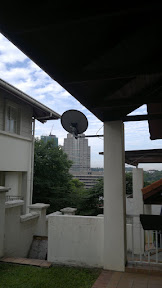In the box
The box is slim this time round, with some nice graphics and is 100% recyclable and made out of recycled materials. There isn’t a lot that is bundled in the box, just the minimum to get the user started. The “standard sales package” section on the N8′s specifications page isn’t entirely accurate, actually. There is no BL-4D battery as it is sealed inside the N8, and the user cannot easily remove the cover to replace it. The user does get these though:
- mini HDMI to HDMI cable to connect the N8 to an HD LCD/plasma/LED TV to play multimedia content
- USB on-the-go cable so that you can plug in a thumbdrive or portable hard disk to the N8 and use the N8 to display photos, play music or play video content on the external storage device
- USB to micro USB cable for charging and data transfer with the computer
- AC adapter with 2.5mm charging pin (no USB output port though)
- wired headset
- user guide, warranty card, quick start guide, privacy booklet
- Rihanna “Rated R” free album download voucher
- 25 free music tracks from Nokia Music Store voucher
Hardware
The N8 feels great in the hand. It’s only 135 grams, lighter than most high end smartphones I’ve tested. Although light, it doesn’t feel cheap at all – build quality is very high, with a fair amount of metallic material used in its construction. In a word – it feels solid.The phone feels right in the hand – I think that 3.5 inches of screen size hits the sweet spot in terms of form factor, and explains why Apple has not budged from this since the early iPhone days. It’s easy to hold, fits most palms, even those of the fairer gender. I have to admit that because of the metallic finish, the phone feels a little slippery, and perhaps some amount of rubber along the sides would not go amiss for a better grip.
On the front is the large 3.5 inch AMOLED touchscreen supporting 640 x 360 pixel resolution. The screen renders colours very nicely indeed – colours are bright, and vibrant. Touches register well, and swiping from screen to screen or option to option is easy. Viewing angles are good – I can put the phone at eye level, almost flat, and I can still see the details. Multi-touch, otherwise known as pinch zooming, works very well.
Picture quality on the N8 seems more “naturally” rendered. If you compare the same picture on the N8 and iPhone 4 below, the blue on the iPhone 4 seems “fake” although the colours look more lively. Both devices were set to 50% brightness. I have to say that the maximum brightness setting on the N8 is probably only 70-75% of the max brightness of the iPhone 4 though, and wonder why Nokia did not see fit to make the display brighter – perhaps to conserve power?

Below is the photo used for comparison. Download it from my Picasaweb account if you want to see a much clearer version.
The screen, as is usually the case with all newer smartphones on the market today, attracts fingerprints and smudges easily as it also has a glossy surface. The AMOLED screen technology does give the phone an edge over other smartphones when viewing under direct sunlight, although I don’t understand why this is often cited as a competitive advantage – you try standing under the Malaysian midday sun admiring your smartphone’s screen quality for more than a minute and tell me how you feel!Next to the earpiece in the centre is the proximity/light sensor, and next to it, the front facing video call camera which can also be used to take pictures. At the bottom is a single button which calls up the menu, and next to it, the microphone port.
On the back is the 12 megapixel camera, the hallmark of the phone, with a Xenon flash (to its left), a rarity in smartphones today. Next to the camera lens is a speaker port, and nestled at the bottom right corner of the slight protusion that is the camera lens area, the microphone, presumably for video recording. I am unsure if this microphone is used for noise cancellation during a voice call – I doubt it, as I can’t find any mention of this in the specifications.
There is a slight protusion where the camera lens and flash area is at the back of the phone – not something totally unexpected of a newer smartphone on the market nowadays because of the higher megapixel camera lens packed into them which necessitates this. The lens, in addition to having an outer glass protective layer, also has a shutter that will close when the camera is not in use. My only concern with the camera lens area is that the lens area glass may get scratched if one places the phone on its back on a dirty surface, although I have to admit that this is not likely to occur because the glass is set back from the surface a little.
On the left of the device are the microSD and SIM card slots – both are spring loaded. Finally, on this side is the microUSB port as well as the USB-to-go port where you can connect a thumbdrive or portable hard disk. To the left of the microUSB port is a tiny light indicator which will light up when the phone is being charged, and will go off once the battery is fully charged – a useful visual indicator indeed, without having to turn on the phone to check.
On the bottom, there is a slot for the lanyard, and the 2.5mm charging connector is here as well. On the right is the volume rocker key, lock key and dedicated camera key. At the top of the device there is the 3.5mm headset/AV port, the mini HDMI port and the power button.
As you can see, the N8 does sport a variety of buttons, more than a competing smartphone such as an Android or iOS device.
The g-sensor or accelerometer is sufficiently sensitive and fast – rotating the device will rotate the screen quickly wherever it is supported – no fancy animations to slow the system down.
HDMI out
The N8 has an HDMI out port, a rarity indeed on smartphones today, and explains why it is positioned as an entertainment device by Nokia. When connected, the contents of the screen will be output to the HDMI compliant external device – the homescreen in both portrait and landscape orientation (on both the N8 and HDMI device), photos (no multi-touch in this mode though), videos (videos will only play back on the HDMI device, not the N8) and games (both N8′s screen and HDMI device). I can’t say anything else apart from that it works as advertised, and it works well. There’s no need to toggle output – once the cable is plugged in to the N8 the video will be sent automagically to the HDMI device.
USB on-the-go (OTG)
This is a mode where the user can attach a thumbdrive or external portable hard disk and have the N8 try to open files on the device, such as video, audio, text, PDF, photos, or any other supported file types. Again, just like HDMI out, USB OTG works as advertised.
Voice call quality
This is not something I typically would test nor bother writing about when reviewing Nokia phones as the quality is normally unrivalled, and the N8 is no different – call quality was excellent, as expected; voice calls were clear, with no interference. And as I have always emphasised, the quality of the call is as much dependent, if not more dependent, on the quality of your cellular operator’s network.
Battery life
This is an area so subjective that commenting on it is almost meaningless as everyone’s usage scenario is totally unique. But suffice it to say that I suspect the N8 will be a charge-daily-device for most people. It is likely to last me a day with my usage scenario slightly modified to suit the N8′s strengths and taking into account its shortcomings compared to other mobile platforms that I use, and I’m sure the battery on my review unit is not conditioned yet as I’ve only had it for about a week, and charged it a handful of times.
Operating system and softwareIn terms of operating system, the N8 uses Symbian^3 (since simplified to just “Symbian”). Symbian^3 is optimised for touchscreen devices, more so than previous versions such as S60 v5, first introduced when the Nokia 5800 Xpressmusic touchscreen smartphone was released. Symbian^3 also attempts to reduce the number of taps necessary to achieve something, as well as simplifying some system related activities such as the installation of new software on to the phone. An example is when sending a file(s) through Bluetooth (BT) when BT is not turned on – in previous Symbian versions the device will ask you whether to turn on BT to send the files, and then leave BT on after the files have been sent. In Symbian^3, the process of turning on BT for file transfer and then turning off after file transfer is complete is transparent and automatic to the user, which is an extremely nice touch indeed.
Make no mistake – Symbian^3 is an evolution, and not a revolution in Symbian’s user interface (UI). The UI has of course come under constant criticism for not “keeping up” with the competition, notably Android and iOS, and I, for one, hope to see a much more streamlined and efficient user interface soon, now that Nokia has decided to focus exclusively on using Qt as its development platform going forward.
One nice touch is that there are user guides in almost every important app – tapping the “Option” button normally brings up an option called “User guide” which will display context sensitive help pertaining to that particular app or function being accessed – at least there is no need to constantly refer to printed material for help.
The N8 is capable of multi tasking, of course, and you can open a number of applications and leave them running in the background to go back to later, quickly. To help the user do that, a app/task manager app which is triggered by a long press of the menu button is provided – from this app/task manager the user can switch quickly to another open app or terminate an open app altogether by pressing the “X” at the top right corner of an app’s icon.

With Symbian^3, navigation using the touchscreen becomes more friendly and easier. There are now 3 configurable homescreens, with the second and third one able to accommodate 6 widgets (which can be shortcuts to applications, or small programs to fetch live content from the internet). Additional widgets in addition to the pre-loaded ones can be downloaded from the Ovi Store. On the leftmost homescreen, only the clock widget cannot be removed. The inclusion of multiple homescreens is a most welcome addition as the user can now add a lot of application shortcuts and widgets for easy and quick access to information.
The homescreens can also be rotated to landscape mode.
Pre-installed apps
See below for a complete list of the pre-installed apps on the N8 (the only exception being the Best Screen Snap software which I installed to take screenshots). As you can see, the N8 ships with a respectable amount of pre-installed apps. The usual personal information management (PIM) apps such as contacts, calendar, notes and clock are present.
Quickoffice and PDF Reader
An office productivity app suite supporting Microsoft Office 2007 is also provided by Quickoffice – sadly, this is “view” only, and the user needs to pay for the ability to edit Word, Excel and Powepoint documents. And it’s not cheap either – the regular price is US$29.99 although there are some periodic promotions where one can enjoy a discount of up to 50% off the regular price.
A PDF reader is bundled as well as part of the Quickoffice app suite – Adobe Reader LE 2.5. I’m not certain why Quickoffice forces the user to register the software – failure to do so means that the user cannot use the apps. A strange move, if you ask me, and I would have much preferred to bypass this potential invasion-of-privacy step. The reader supports screen rotation using the g-sensor. It is not touch friendly, however, and dragging the scroll bar is easier than flicking through the items on the screen. Pinch zooming is also not supported.
While zooming, there is no automatic text reflow that will reflow the text to fit the width of the screen so that the user does not have to pan left and right to read a document. Finally, the navigation buttons (scroll up/down and zoom) take up almost 15% of the screen and do not disappear automatically after a period of time, taking up valuable screen space! Overall, one gets the impression that this is one software that is stuck in days gone past, and if you have experienced PDF reading on other competing platforms, you would definitely not want to bother reading PDF documents on the N8. This app is in serious need of an upgrade.
WebTVThis app is one of the selling points of the N8. While the user can watch a wide variety of international content such as those from National Geographic, CNN and E!, there is also local content pre-loaded on the device from 8TV, TV3 and Virtual Malaysia (this app doesn’t seem to support viewing in landscape mode, which is rather strange!). When starting up the app/widget for the first time, the initial loading can take quite long.
I have to admit it’s quite a novelty watching TV content on a small screen device over a wireless connection, and overall the app works well – of course a lot of the enjoyment will depend on the quality of your wireless broadband connection as well. These apps are actually widgets which fetch their content from the internet, rather than “real” apps.
Web browser
The built-in browser is webkit based, the same that powers the built-in browsers on the Android and iOS platforms. It supports pinch zooming, and double tapping will also auto zoom the page to a pre-defined level. While browser performance is hard to test because it also depends greatly on the quality of the internet connection as well as the ability of the destination website to serve up the requested page, when I tested the browser on a couple of websites, including my own, the page loaded quickly on a 3G connection.
Scrolling is acceptable, although not lightning fast as on other platforms, at least when tested on my own website, which loads up around 900KB – 1MB of content. Scrolling is also not as smooth as on other platforms. Kinetic scrolling is implemented, again, it is not as well implemented on other platforms. Scrolling fast up or down a webpage does not show the “checkerboard” effect.
Adobe Flash is supported – the visitor counter on my website loads up without any fuss. I can also play YouTube videos on the webpage itself without having to load up a dedicated YouTube app to play the video, which is nice, and is of course much better than competing platforms!
Multimedia playback
The music and video players do their jobs well. Features such as album art, background play, and the creation of playlists are all supported by the music player. Since there is only a single speaker at the back of the phone, located near where the camera lens is, one should not expect boombox quality sound coming from the N8, but for personal music listening pleasure, piping it out through the single speaker is more than sufficient, and if one needs better quality, use the headset instead. Having said that though, the speaker is pretty darned loud, at least to me, on maximum volume!
In portrait orientation, the music player app will display a list of albums. In landscape, it will display the albums in “cover flow” style with some nice fancy animations as you scroll through the list of albums on the device. There’s an FM transmitter where you can broadcast whatever is playing to the airwaves so that a radio tuner can tune into the frequency you’re broadcasting on to receive the audio – for example, you can play audio files on the N8, and use the FM transmitter so that your car’s radio can pick it up and blast it over your car’s speakers. Sound enhancement isn’t fancy – there’s an equaliser, and loudness as well as “stereo widening” whatever that means!
I tested the video player with four file types, all downloaded off the internet. These were AVI, MKV, RMVB and MP4 files in varying resolutions. Playback of the AVI, RMVB and MP4 files played fine; time scrubbing worked. Playback was smooth and no stuttering was detected. Audio/video were in sync. The MKV file refused to play, most likely due to the absence of codec support for this file type.
Sound output through the speaker was good, although this will depend on the audio quality of the video file, but for the videos I tested, the audio was certainly very audible even at 50% volume.
Apologies for having to use a camera to snap a picture of the screen for the last two pictures – the built-in screen capture app refused to capture anything, most likely due to system resources being low after the video app was playing a 1280 x 720 pixel MP4 video file!
Photos app
The photos app is a bit of a misnomer really – it shows images as well as video files. As an image is chosen to be displayed, the user can flick back and forth between all the images in the device, as well as open an image editor to edit the image. Basic editing functions are supported – such as red eye reduction, cropping, rotating and applying special effects to the image, so there is no need to transfer a picture to the computer for simple editing tasks – a useful app indeed.
Camera and video capture
The 12 megapixel camera, along with the 720 pixel HD video recording, is undoubtedly the star of the show on the N8. The inclusion of a Xenon flash, a rarity in smartphones today, means that the user can take “flashed” pictures of a longer distance compared to smartphones equipped with only LED flashes. Options and settings are plentiful – see the pictures below, but I wish there were more options when it came to specifying the resolution of the pictures to be taken, rather than be limited to “just” 0.3, 1.3, 3, 9 and 12 megapixels.
Rather than rambling on and on about the picture quality, check out the pictures below taken by the N8, and the corresponding ones taken by the iPhone 4, which I would consider to be the next best popular camera-smartphone on the market today. Click on the thumbnails to access the full sized, unedited versions on my Picasaweb account to see EXIF information, etc. All pictures were taken on full auto mode.
Pictures taken with Nokia N8:
Pictures taken with iPhone 4:
I’m not an expert photographer by any means – heck, I’m not even qualified to be called an amateur photographer either, so I’ll leave it to the experts to comment on the quality of the pictures. I just want end this section by saying that the N8′s camera app seems fond of triggering the flash when I felt there was no need to (and I hate flash as it “destroys” the picture most of the time), there is no “tap-anywhere-on-screen-to-focus” feature present on competing smartphones, and the camera button, while an excellent addition, seems a little stiff to press to release the shutter. I think this could be one of the reasons why there is also a “soft” button the user can tap, located at the bottom centre of the screen, to take a picture, rather than having to physically press the dedicated camera key. Having said this however, it is a difficult choice to make because there is a trade off between an easy-to-press button and the need to avoid accidental-button-presses.
Here’s a sample video captured in high definition 1280 x 720 pixels, with video stabilisation on. Again, I’m not an expert to comment authoritatively on these things, but I think the quality’s pretty darned good! Do watch it in HD ;-)
Social app
The social app is a new app, present first on the N8, which brings in feeds from your favourite social networks of Twitter, Facebook and RenRen (don’t ask me what this one is!) into one single integrated screen so you don’t have to switch between different apps to see what your social circle is up to. You can update your status (including sharing of pictures from the gallery or taken straight using the camera) from within the Social app, and there is a widget that can display the latest feeds from your social circle on the homescreen. Sadly, only one Twitter and Facebook account can be online at any one time.
The Social app requires a Nokia account, which is also used for access to the Ovi Store, backing up contacts/SMS to the cloud and Ovi Maps. As is expected of any version 1 of any app, the app can be a little slow at times but not slow enough to be a pain.
Other notable apps
Video editor
The video editor provides some simple and easy to use functions to enhance the videos taken with the N8 quickly. The effects that the user can apply are limited to adding captions to a video, cropping it, adding transitions, adding a soundtrack to a video and creating a slideshow out of a series of pictures. The resulting video file is then saved as a new file, ready to be viewed on the device or output-ed to an HDMI compliant external device.
Ovi Maps
Ovi Maps, as usual, was rock solid. Voice navigation is of course free for life, as are the maps. Maps can be loaded using Nokia’s Ovi Suite software before heading out to save on data usage charges. The software is constantly being updated to improve its usability, and free content such as Lonely Planet and Hungry Go Where is helpfully included.
Radio
An FM radio app, which works when the headset is plugged in (as it acts as the antenna) is included.
KL traffic
This app shows still images from traffic cameras from the ITIS website.
Conclusions
The Nokia N8 is undoubtedly the best Symbian smartphone so far – it’s packed full of hardware features. Software has improved over previous versions, and there is at least an app from Nokia that tries to turn the phone into a “socially aware” one, with support for Twitter and Facebook. Coupled with an increasing number of apps in the Ovi Store, there should be more choices for the consumer going forward for each type or class of app.
Will Symbian^3 win over users from other competing smartphones, especially Android and iOS? The short answer is, I think, no, not yet, unless we see a complete overhaul of the user interface, which still has some unwanted and unneeded legacies from the “old” Symbian – button sizes and looks are not yet fully standardised, for example. Sometimes it takes too many taps to achieve a simple function such as turning Bluetooth on or off (yes, one can turn BT on/off by tapping the “call” button, and pressing and holding the “*” button, but who would know this, right?). Another reason why the existing incarnation of Symbian would not really attract users from competing platforms is because of the never-ending bad press, sometimes unjustified, that Nokia receives from the Western online and “old” media.
But if you look beyond the shortcomings of Symbian, and consider the “value” of the N8, where value is defined as hardware features, software, operating system and user experience compared to the price that you pay for the N8, it is hard to beat. After all, for only RM 1,690 (cheaper if you know the right people), you do get a phone packed with excellent hardware features (12 megapixel camera, Xenon flash, HDMI out, USB OTG), a rock solid mobile operating system and an increasing number of games specially written for the N8 (eg. Angry Birds, Rally Master, Real Football, Asphalt 5 – all of which sport really nice graphics and gameplay), I think this would be a worthy consideration.
So, to sum up – for existing Nokia/Symbian users, upgrading to the N8 is a no-brainer – just do it! For RM 1,690, it is so cheap that one doesn’t need to think twice – after all if you paid in excess of RM 2,000 for the Nokia N97/N97 Mini or even the N900, the N8 is certainly an upgrade. For new users who are not currently using any other smartphone platform, it is a worthy alternative to consider, value wise. For users of competing platforms, you are likely too set in your ways to think about anything else, let alone Symbian.
Source : http://mytechnews.info
Source : http://mytechnews.info















































































































0 comments:
Post a Comment